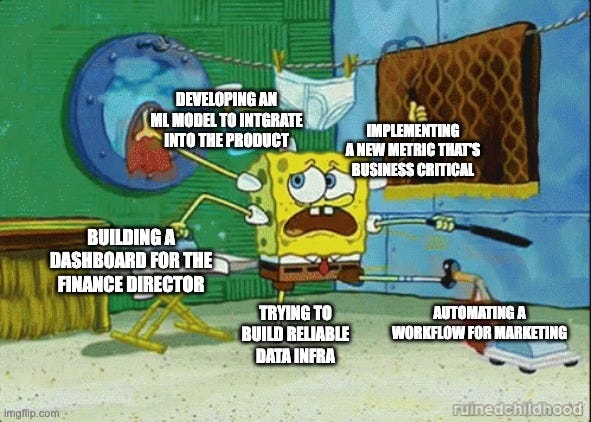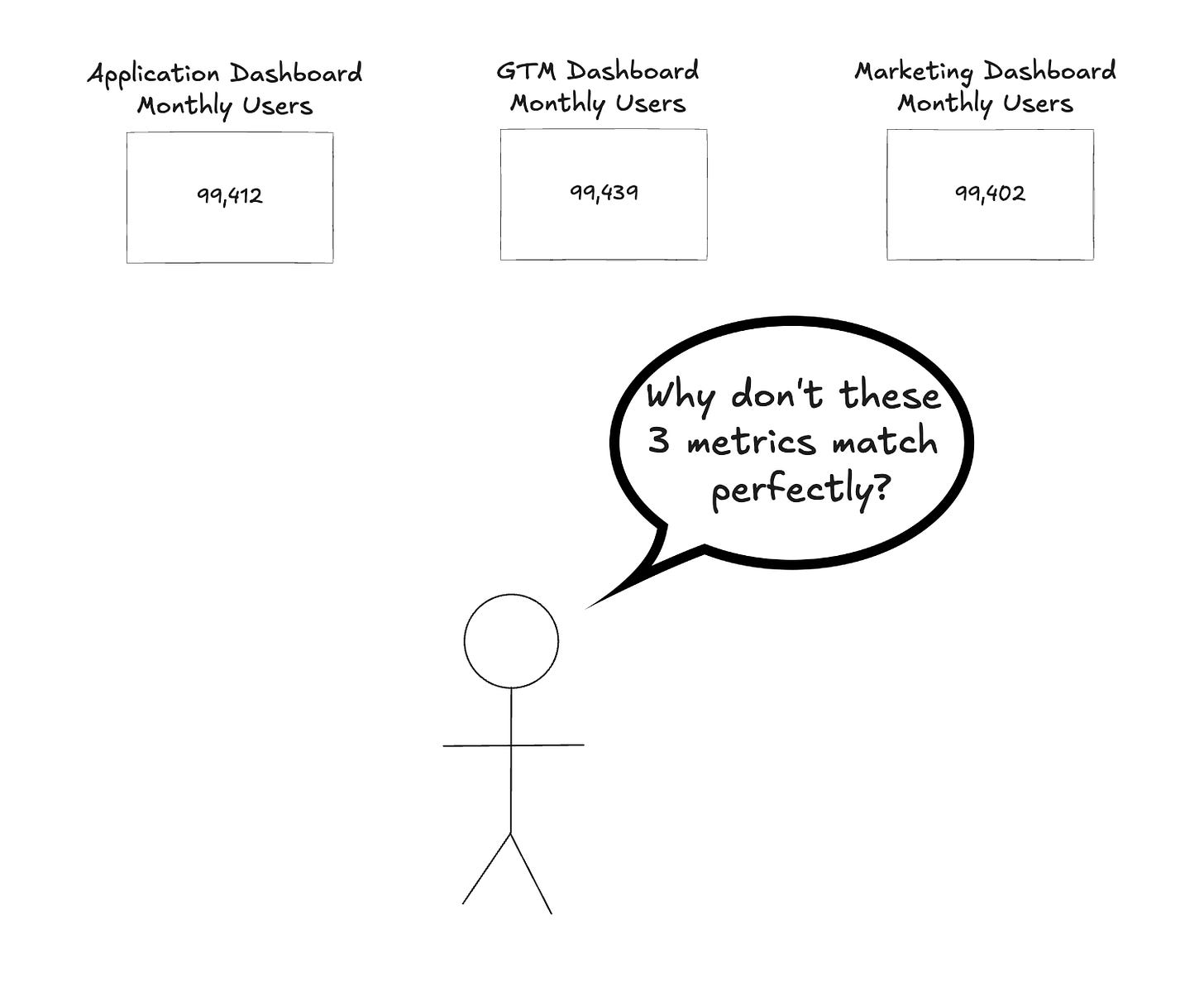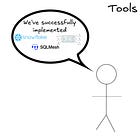“The First Data Hire” Series: How to Survive and Succeed as a Solo Data Leader
Everything they didn’t tell you when you took the job
Hi, fellow future and current Data Leaders; Ben here 👋
I’ve had a few conversations with data experts who just started a new role as a data leader or are the first data hire. This is always a challenging situation as you’ve got to set expectations and have to develop much of the infrastructure yourself. So I wanted to write an article series about being the first data hire.
But before that, if you're a data leader looking to understand what is going on in the broader data world as well as elevate your leadership skills, consider signing up for my 6-Week Data Leaders Playbook Accelerator program that I will be running in September!
Now, let’s jump into the article!
Being the first data hire is one of the most common (and chaotic) experiences I hear about from data engineers and analysts.
Sometimes you’re the first hire for the entire company. Other times, you’re brought in to support a single department. Either way, the situation tends to feel the same: exciting, overwhelming, and a little bit absurd.
On one hand, you have a blank slate. You get to build what you think matters. On the other, there’s no process, no standards, and everyone wants something from you, yesterday.
Leadership might assume you’ll wave a magic wand and spin up the same infrastructure they had at their last company, where a 20-person team shipped real-time dashboards and full-blown applications already integrated with AI and delivering insights.
Meanwhile, you’re one person staring down 30 semi-automated workflows cobbled together in Google Sheets, Access, and a random script Terry developed back in 2018. Plus a backlog of 100+ requests from people who don’t know what they want, only that they want it now.
So, where do you start?
That’s what this article is about. Whether you're new to the role or just walked into another "first hire” situation, I’ll walk through the most common mistakes, the frameworks I’ve seen work, and how to prioritize projects when everyone’s asking for everything.
Mistakes New Data Leaders Make
Before we get into what to do, let’s talk about what not to do. These are some of the most common mistakes I see new data leaders make. I’m sure there are more, if you’ve experienced this, feel free to share your own below so others can learn from them, too.
Trying to Solve Every Problem for Every Leader at Once
One of the biggest traps early on is trying to please everyone. I recently spoke with a data leader about how to juggle requests from half a dozen stakeholders with no clear priorities and nowhere near enough bandwidth.
Sure, hiring more help is ideal. But realistically, you’ll hit a point where you have to make tough calls. You can’t solve every problem. And more importantly, you shouldn’t have to. You need to communicate who you can and can’t support. What will and won’t be done. Just because you can try to track a dozen levers and metrics doesn’t mean you should. The challenge here is, when you’re the new data leader, people will come to you. They will have long lists, they will try to find ways to become a priority, whether what they want aligns with the business goals or not. I can promise you, it will be overwhelming all while you’re trying to wrap your head around the companies data infrastructure.
When you’re first getting started, focus on discovery. Interview key stakeholders, learn their goals, and figure out which ones align with broader business objectives and have an interest in partnering with you.
From there, build a simple prioritization matrix to help you decide where to focus your time and who you’re realistically able to help.
Neglecting to Build Relationships
No matter who you end up supporting, building strong relationships across the business is non-negotiable.
It’s tempting to hunker down and focus on delivering dashboards or machine learning models. But shipping alone isn’t enough, those tools still need to be used, integrated, and maintained. If you’re building a dashboard, who’s going to embed it into the workflow? Do they even know you’re working on it?
Beyond implementation, relationships help surface better problems to solve. When you’re regularly talking with stakeholders, outside of just gathering requirements, you’ll start to hear the real challenges they’re facing. The ones they may not mention in a formal request. That’s where some of your most valuable, creative work can come from.
Focus Purely on Tooling
I’ve said this before, but it’s worth repeating: building infra for the sake of infra is a great way to never deliver anything the business needs. It’s also a great way to lose trust.
I’ve seen teams go all-in on the “perfect” architecture or the latest tool, only to emerge weeks later with a solution no one asked for. Or worse, a dashboard with numbers the business doesn’t trust.
If you don’t bring stakeholders along for the ride, don’t be surprised when they question the output. Technical elegance doesn’t matter if the business can’t use (or believe in) what you’ve built.
Guiding Principles for a Startup Data Strategy
Now that we’ve covered what not to do, let’s talk about principles you can use to better approach building your data infrastructure.
Also, if you’d like, I recently ran a live webinar discussing this very topic!
Start Simple, Focus on Value
It sounds obvious, but it’s easy to forget: most businesses don’t need the perfect infrastructure, they need answers.
I’ve seen too many teams chase perfection when all the business needed was a handful of reliable metrics.
I mean, the amount of times a pivot table would have answered more questions that the overly complex dashboard the data team did end up developing…
In many cases, you can get by with something as simple as a replica of your database and run your analytics from there, and that’s more than fine to start with.
Balance Speed and Scalability
If you’re the first data hire, the business will likely have:
A lot of requests
No process for how to actually use data
So your job early on isn’t to build a full-blown data warehouse. It’s to find simple, practical ways to use data to move the business forward.
Start by delivering a few key reports or even just a light analysis that give insights into things the company can’t currently see or can’t answer. For example:
Churn is higher than expected - Can you answer why and which segments are actually churning or at the highest risk to?
Customer acquisition costs are trending up - figure out if certain channels are underperforming or if marketing spend isn’t aligned with high-LTV customers, and suggest reallocations.
Inventory levels are inconsistent across systems - trace how data flows from suppliers to warehouse and POS, identify where mismatches occur, and work with operations to fix broken processes or integrations.
That way the business gets familiar with using data and you get familiar with the data that represents the business.
Trust and quality > quantity
There are a lot of conversations around the speed of development for data team. Yes, leadership wants insights fast, but constantly churning out dashboards with bad or inconsistent data is a quick way to lose trust.
Whether you’re generating AI SQL slop or just turning your data team into a dashboard factory.
The more dashboards and data products you create, the more likely it is that things won’t reconcile. So even if the business is asking for 100 dashboards, take a step back and consider the following:
A 1,000-person company probably doesn’t need 100 dashboards
Multiple dashboards tracking the same metric with slight differences only create confusion
Every dashboard you build adds to your maintenance and overhead
It’s easy to fall into the “more is better” mindset when you’re the first data hire. I know that was me! But more can mean distraction, inconsistency, and a never-ending cycle of upkeep.
Finding The Right Projects
Finding meaningful projects starts with a deep understanding of the business. As data engineers and analysts, we have unique access to core metrics and raw data, giving us the tools to ask better questions and uncover insights others might miss.
The key is taking a moment to pause and reflect, rather than defaulting to shipping pipelines and dashboards. Ask questions about the data and how it connects to business outcomes.
For instance, if you work at a Starbucks, McDonald’s, or a Cava-type restaurant, a core metric might be comparable store sales. In a hotel, it’s probably Occupancy and average daily rate. But knowing the metrics isn’t enough, you need to understand what moves it.
Ask yourself:
What factors actually impact occupancy?
Was there a clear reason it dropped this week, like seasonality, a storm, or a local event?
Are competitors pricing lower?
If we reduced prices, would we see an increase?
If you’re still trying to figure out how to find the right projects, I’ve written a near chapter’s worth of content here.
Getting Buy-In
During your first month(or in some cases just the first few weeks), you’ll probably get a bit of grace. People expect you to ramp up, learn the business, and identify gaps and opportunities. But soon enough, you’ll need to start delivering value, and that means getting buy-in for projects.
Congrats…you’re in sales!
said it well in her interview with : a lot of us get so caught up in logistics, we forget to focus on the sales.The Abstract Is Hard: You’ve heard “show, don’t tell.” Even if you can clearly explain your project, it helps a lot to show a tangible mock-up. Visuals reduce ambiguity and make your work easier to rally behind. I enjoyed the way Shachar Meir put it describing 1-hour, 1-day, or 1-month versions. If you can build an initial version of something in an hour so people can see it and understand the value you can get far more buy-in.
Anchor to Pain Points: People buy into solutions when they clearly solve something painful. I know, we all have the same inclination to lead with WHAT and HOW we’ll be using to solve the problem instead of WHY it even matters. Sadly this requires us to have some empathy and understand, well, other people and their needs. Instead of “We should build a churn dashboard,” try: “We’re losing 15% of customers each quarter, here’s a quick analysis on why.” Now the value of a deeper project is obvious.
Enlist Champions: Find someone influential who feels the pain your project solves. If they’re excited, they can help champion the idea internally and build momentum with peers or leadership. I know it can be tempting to try to solve every problem on your own. But the world, fun fact, does not revolve around you and other people would love to help(as long as you can show them why they also benefit).
Celebrate and Communicate Early Wins: Some people wait too long to share progress. Don’t. As your team hits milestones, keep stakeholders in the loop. Let your champions know, and keep reinforcing the momentum. (Let’s be honest, some execs ride a single win for months. You can too, as long as you’re building on it.)
Frame Options with Trade-Offs: Sometimes, buy-in stalls because stakeholders can’t decide. I mean, they likely feel like they have dozens of options. Should they invest in project A, B, C, Z? What could be the consequences of said decisions? Make it easier for them by presenting options: “We can do X in one week or Y in three weeks with more depth.” This gives them a sense of control and shows you understand time and resource constraints.
Communicating and Aligning with Stakeholders
As you start completing projects and pitching new ones, your ability to communicate clearly becomes just as important as your technical skills. I recently wrote an article abut this so you can check it out below.
Final Thoughts
Being the first data hire isn’t rare, and it’s definitely not easy. When I posted about this recently, more than a few people reached out to share their own experiences. It’s a tough spot to be in, but far from impossible.
The key is setting expectations early. Otherwise, you risk becoming a dashboard machine, cranking out reports no one actually uses.
I’ll be writing a follow-up piece soon on what I’ve seen work as companies start building out their data teams. If you’ve been through it yourself, I’d love to hear what worked (or didn’t) for you.
As always, thanks for reading!
Don’t Miss Out On These 6 Free Data Leader Webinars Coming Up In July
What Every Data Leader Gets Wrong About Optimization with Paul Stroup
Building Streaming Pipelines for Real-Time Analytics with István Kovács
From Reactive to Proactive: Managing Stakeholders to Unlock Strategic Data Work with Celina Wong
Integrating ML Workflows Into Data Pipelines with Jeff Nemecek
Beyond the First Use Case - Building Data Platforms and Processes for Long-Term Adoption with Patrick Taggart
Join My Technical Consultants Community
If you’re a data consultant or considering becoming one then you should join the Technical Freelancer Community! We have over 1700 members!
You’ll find plenty of free resources you can access to expedite your journey as a technical consultant as well as be able to talk to other consultants about questions you may have!
Articles Worth Reading
There are thousands of new articles posted daily all over the web! I have spent a lot of time sifting through some of these articles as well as TechCrunch and companies tech blog and wanted to share some of my favorites!
The End is Nigh (Again)
By
It’s that time again in the zeitgeist where the end is nigh for programming languages and practices. The last couple of months have felt like a coordinated campaign to declare things like SQL, R, data engineering, BI, analytics, and more as dead or obsolete. Why now? Maybe it’s the changing of the seasons. Maybe it’s the uncertainty about what AI does to our field and tools. Or perhaps we’re once again trapped in the echo chamber of a hype cycle, where people start confusing “what’s hot” with “what matters.”
Contra Ptacek's Terrible Article On AI
A few days ago, I was presented with an article titled “My AI Skeptic Friends Are All Nuts” by Thomas Ptacek. I thought it was not very good, and didn't give it a second thought. To quote the formidable Baldur Bjarnason:
“I don’t recommend reading it, but you can if you want. It is full of half-baked ideas and shoddy reasoning.”1
I have tried hard, so very hard, not to just be the guy that hates AI, even though the only thing that people want to talk to me about is the one time I ranted about AI at length. I contain multitudes, meaning that I am capable of delivering widely varied payloads of vitriol to a vast array of topics.
End Of Day 186
Thanks for checking out our community. We put out 4-5 Newsletters a month discussing data, tech, and start-ups.
If you enjoyed it, consider liking, sharing and helping this newsletter grow!




Well written - as the first data hire in 3 companies it resonates a lot with my own experience :)
Love your posts, super high on signal, great work!